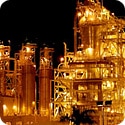Access Agilent eNewsletter, October 2013
>> Update My Profile | Subscribe to Access Agilent | Article Directory

New sulfur column delivers exceptional inertness and minimizes tube coking
By Allen Vickers, Mitch Hastings, Liying Yu, Gary Lee
Agilent GC Applications
Analysis of volatile sulfur-containing compounds is important in a wide variety of industrial and petrochemical applications. Monitoring these reactive compounds is critical for quality control of feedstock, precursors, and final products.
Gas chromatography with the sulfur-selective, chemiluminescence detector (GC/SCD) is the tool of choice for sulfur-contaminant analyses in process streams. However, it is not without its problems. The columns commonly used for GCSCD in these analyses suffer from the paradox of not only needing a thick, high retention stationary phase to provide good resolution of the low-molecular-weight sulfur analytes, but also needing low-bleed performance at the upper temperature range when eluting the high-molecular-weight sulfur analytes. When columns with a higher bleed profile are installed on the SCD, they often contribute to detector overloading. When this overloading occurs, the hydrocarbons/aromatics – along with components of stationary phase bleed – are reduced in the hydrogen-rich atmosphere as they exit the column and can irreversibly “coke” the SCD reaction tubes in the burner. This inadvertent passivation of the reaction tubes causes a rapid decline in sensitivity of the sulfur detector. The only solution is to replace the reaction tube, which incurs both the cost of the tube, and the downtime needed to perform preventive maintenance on the analyzer.
Minimize “coking” and reduce downtime
The new Agilent J&W DB-Sulfur SCD GC column is a wall-coated open-tubular (WCOT) column with low bleed and exceptional inertness to sulfur compounds. It not only separates a broad range of active sulfur solutes at low concentrations but also minimizes the column’s contribution to reaction-tube coking when used with sulfur-selective detectors, especially the Agilent Sulfur Chemiluminescence Detector. This results in improved system ruggedness, and greatly reduced downtime and costly detector maintenance.
 Enlarge
Enlarge
Figure 1. The potential decline in sulfur response after as few as three injections on a standard sulfur thick-film column, 50 m x 0.32 mm, 5 µm.
Hydrocarbon-rich samples cause decline of sulfur signal
When an SCD reactor operates over 800 °C, column phase decomposition can be problematic, especially for the thick-film columns that are often used for analysis of volatile sulfur compounds. Figure 1 shows that as few as three injections of hydrocarbon-rich samples can lead to a decline in sulfur response. Response factors deteriorate as bleed from the degraded column deactivates rods in subsequent runs. In addition, column phase decomposition can exacerbate decline of the sulfur signal due to build up of silicon dioxide in the sample flow path.
 Enlarge
Enlarge
Figure 2. Even after 20 analyses, there is no deterioration of SCD sensitivity when using the Agilent J&W DB-Sulfur SCD, 60 m x 0.32 mm, 4.3 µm.
Stabilize the SCD signal with Agilent J&W DB-Sulfur SCD columns
Agilent J&W DB-Sulfur SCD columns improve thermal stability in thick film columns to stand up to an SCD reactor at high temperatures, lowering phase degradation and exhibiting increased inertness towards reactive sulfur compounds even at 20 injections, as shown in Figure 2.
The new Agilent J&W DB-Sulfur SCD column has now been successfully deployed in multiple hydrocarbon production laboratories with no signs of degradation. The column consistently delivers increased SCD detector stability and reduced instrument recalibration in everyday use with no need for column replacement.
At last, your column and detector work in perfect harmony
The Agilent J&W DB-Sulfur SCD GC column’s exceptional inertness, works with the Agilent Sulfur Chemiluminescence Detector to detect sulfur compounds at femtogram levels in hydrocarbon matrices. Separation of sulfur compounds from the matrix is excellent. This eliminates quenching effects caused by the matrix, giving you a better response for these difficult-to-analyze compounds.
The new sulfur column was developed in response to our customers’ evolving needs. It has worked so well, we are putting it into full-scale production. Now take a moment to learn more about how your analysis can benefit from the Agilent J&W DB-Sulfur SCD GC column along with the Agilent Sulfur Chemiluminescence Detector and our industry-leading Agilent J&W GC columns.
We gratefully acknowledge the figures supplied by Jim Luong and coworkers at Dow Chemical Canada ULC.
>> Update My Profile | Subscribe to Access Agilent | Article Directory

